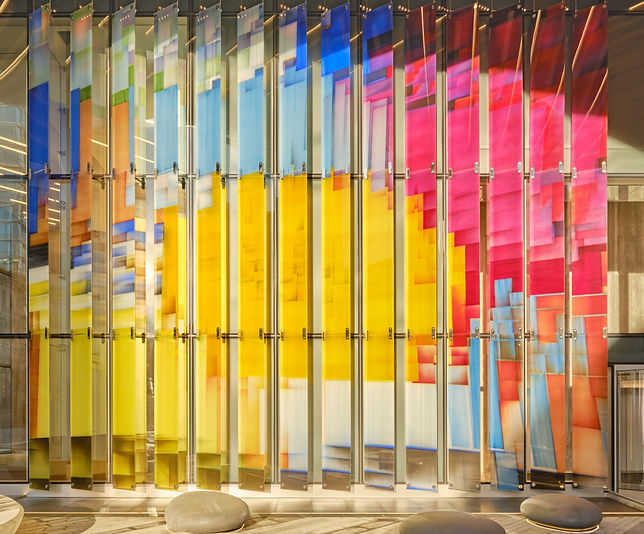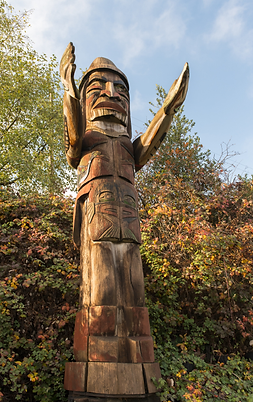Helena M. Ventosa | Sophie Diebold | Vidushy Avasthi
Public Art and Attitudes in Vancouver
1901-2023

Walking Spectrum, Devon Knowles, 2021
Photo by Rachel Topham Photography
Courtesy of the City of Vancouver
INTRODUCTION
This project reviews public art in Metro Vancouver through Information Visualization. It looks at how the types of art, occurrence, and ownership of public art have changed between 1901 and today, and places public art trends in a historical context.
Public art is defined as artwork that is open to the general public, regardless of whether it is situated on public or private property, or if it has been purchased with public or private funds (Tate). Accessibility is an interesting facet of public art since Vancouver is a relatively young city where the lack of affordable space is a major problem. There is a rapidly rising industrial and commercial land value that as a consequence promotes the loss of affordable spaces where artists can share their work (Vancouver City Council, 2019, p. 1).
The data used for this project was sourced from the City of Vancouver Open Data Portal.
Some questions we wanted our InfoVis to answer:
-
How does the popularity of a type of art change throughout the years?
-
Are more pieces of public art privately or publicly owned?
-
Do certain neighborhoods have more privately owned art? Why or why not?
trends in type of art
The dataset included an attribute called ‘type of art’ and we thought it could be interesting to explore how these types of art in public art changed across the years since 1901. The dataset also contains the status of these public art, that is, if they are still in place or not, or if they have been deaccessioned (removed for selling or discard).
The categories in the dataset were mixed and sometimes overlapped. For example ‘Memorial or monument’ and ‘Figurative’ incorporated the same type of art so we created a definition for each category and re-organized the dataset according to these definitions. Here are the new definitions of categories of types of art exemplified (everything below was taken from the dataset except for the definitions):
Figurative: Busts of historical figures

Charles Bentall, 1977 by Jack Harman
Description: This classic bust depicts the entrepreneur Charles Bentall who died in 1974.
Gateway: Portals, pillars, marks of neighborhood and other geographical limits and frontiers

Chinatown Millennium Gate, 2002 by Joe Y. Wai Architect, Inc
Description: The gate demarcates the western entrance to historic Chinatown, and follows the Chinese traditional form of gate design, with one large central arch and two smaller ones.
Fountain or Water Feature: Fountains and non-humanoid sculptures in water

Untitled (fountain), 2000 by Al McWilliams
Media Work: LED lights and panels, light projections, video screens, new media, eletronics

Tidal Pool, 2016 by Curtis Grahauer
Memorial or Monument: Sculptures and statues that make reference to historical happenings or pay homage to historical figures

Chinatown Memorial Monument, 2003 by Shu Ren Cheng
Description: the statues of an 1880's railway worker and a World War II soldier are errected to commemmorate the contributions made by Chinese Canadians to Vancouver and Canada. The main column refers to a Chinese character for "the centre."
Mural: refer to any work painted directly on a wall

Walls of Change, 1998 by Richard Tetrault, Sharon Kravitz
Description: The works consist of 28 canvas and plywood murals designed by artists and community groups and intended to give expression to the many facets of the Downtown Eastside community.
The film Tidal Pool by Curtis Grahauer represents New Brighton Park in Vancouver as a point of articulation between global industry and natural adaptation. The former salt marsh next to the Ironworker’s Memorial Bridge early on had a swimming pool that was filled by the tide. When the waters became polluted by industry, a new pool was built. Waterfowl adapted and settled in the pool through the winter months. Now there is an initiative to turn the edge back into a salt marsh. The film contemplates the site as a pivotal place of contestation between the natural and industrial forces of the coastal city.
Mosaic: refer to the practice of mosaics

British Columbia Beginning, 1958 by Bertram Charles Binning
Description: This 13 'x 44' mosaic done in ceramic tile is a complex of geometric form and line, a modernist abstraction in golds, browns, and reds. A maquette of the mosaic is held in the collection of the Vancouver Art Gallery, as detailed in the book "BC Binning" produced by the VAG.
Relief: refer to the practice of reliefs

Untitled, 1970 by Paul Deggan
Sculpture: Sculptures not classified as ‘Figurative’, ‘Fountain or Water Feature’, ‘Gateway’, ‘Memorial/Monument.’

Girl in Wetsuit, 1972 by Elek Imredy
Description: A life size bronze statue of a woman in a wetsuit, with flippers on her feet and her mask pushed up on her forehead, sits on a large intertidal boulder just offshore of Stanley Park. In September of 1968, Douglas Brown, a Vancouver lawyer, talked to sculptor Elek Imredy about his desire to commission a sculpture inspired by the famous Copenhagen mermaid, which could be sited on the great granite boulder just off the northern shore of Stanley Park. Imredy proposed a life-size bronze sculpture of a scuba diver.
Site-Integrated Work: works built with the architecture of the space, part of the environment it was made on.

Waft, 2017 by Neil Campbell
Description: This public artwork includes the marble-tiled lobby floor of The Exchange building at the Pender Street entrance and the marble-tiled lobby floor of the Old Stock Exchange building at the Howe Street entrance. In the Pender Street lobby, the undulating design follows from the tradition of Portuguese pavements. The pattern, executed in three contrasting colours of stone, extends beyond the lobby entrance and across the adjacent sidewalk to the curb.
Socially Engaged Art: refers to the socially engaged aspect of their making and/or outcome, their central aspect is to engage and gather communities

Brawl, 2010 by Norma Art Collective
Artist Statement: Artspeak presented Brawl, a new performance work by the Vancouver artist collective Norma. The performance occurred on Andy Livingstone Field, dramatically lit by lights normally used for sporting events.Tying in ideas of sport and spectacle at the crossroads of contrasting areas of the city, Brawl highlighted the fine line between violence and theatre. By extending the collective's interest in exploring group identity, public space, and collective behaviour, their choreographed and scripted performance included texts and actions drawn from historical archives, film, and popular culture. Norma’s work troubles the defining actions of fan and protestor, peacekeeper and instigator.
Welcome Figure: Indigenous welcoming figures

Untitled (Welcome Figure), 2006 by Darren Yelton
Description: The standing Welcome Figure was erected by the Squamish Nation. The land was once the site of a traditional Squamish village called Sun'ahk.
Totem Pole: refer to the Indigenous’s totem poles

The Totems, 1972 by Art Sterritt
Two-Dimensional Artwork: Prints, banners, posters, flags

Description: This pair of totems were carved by Art Sterritt, in the traditional Gitxsan style. The totem on the left features the crests of the Gispudwada (Killer Whale Clan) and depicts the killer whale, the octopus and the matriarch. The totem on the right contains crests of the Laxsgiik (Eagle Clan), including the beaver, the frog and the shark. Originally from Gitanmaax at Hazelton, BC, the totems were part of a collection commissioned by Sun Life of Canada, prior to their installation at the Museum of Vancouver and the Vancouver Convention Centre.
A Tale of Two Children: A Work for Strathcona, 2005 by Ken Lum
Description: Two large aluminum frame panels are printed one side with an image and the other side with a text. One shows an unhappy caucasian boy and the text reads, "What an idiot! What an idiot you are! What an utterly useless idiot you are!". The other shows a smiling young Asian girl and an adult woman and the text reads, "You so smart. You make me proud you so smart. I so proud you so smart."
Some conclusions can be made about the trends in type of art, like the fact that sculpture is the most prevalent type of public art across time and one of the most lasting types of art as well. In 2016 we see an explosion in the number of Murals, adding up to 42 murals, which is the highest rate we see within a year compared to the other years and art types. The second biggest rate of type of art in a year was Two-Dimensional Work in 2020, adding up to 27 artworks. In the beginning, starting from 1901, the prevalent Types of Art however are Memorial or Monument, Totem Poles, Fountain or water feature, and Figurative up to the 1950s. Then we see the emergence of Sculpture as one of the main types of art, followed by Site-Integrated work around the 70s and 90s. Media Work, Murals, Two-Dimensional Art, and Site-integrated works gained force around the 2000s and this pattern continues until 2024 although murals seem less popular since the pandemic, after 2019.
Installations over the years

The goal here is to visualize any notable trends in the number of installations per year from 1901 (first public art installation according to our dataset) to 2024 (the present day). The main attribute we looked at to plot this visualization was the year of installation. It is interesting to note that there is some correlation with our “Trends in Types of Art” InfoVis. Evidently, 2016 was a good year for murals.
This is an interesting visualization when taking into consideration the fact that Vancouver is a relatively new city. This proves that over the years, there has been a push for public funding in favor of those things that help foster culture. Art has the ability to raise awareness and educate people, and when it is displayed publicly, these statements make their way to more audiences. It would be interesting to see a data set that approaches public art in Vancouver through demographics to note what kind of voices are being most amplified.
location map
The idea for the location map was to have an interactive viz that would allow users to navigate across the city and see neighborhoods where art installations are located. The use of a GeoJson file type made it easy to create a map since that file comes with the geospatial component integrated with the file. We used the coordinates to mark places on the map where art installations are located. These marks were then color coordinated by neighborhood to make them more distinct from other marks that appeared nearby but were in a different neighborhood.
Ownership Distribution
It’s nice to see that most public art in Vancouver is actually Public! The runner up was “Privately owned” with no further information. Because the dataset did not provide any more detail, there is a knowledge gap present, and all pieces that fall within this value could, in actuality, belong to any of the subsections we came up with. The third largest category were those with unknown ownership, so we have another knowledge gap as well. From the data we had access to, most privately owned pieces are owned by a non-profit organization, or a society. It was also surprising to see that two pieces in the dataset were owned by a sole person. One of them being owned by Bob Rennie, an art collector, and another one being owned by the artist Janet Echelman.